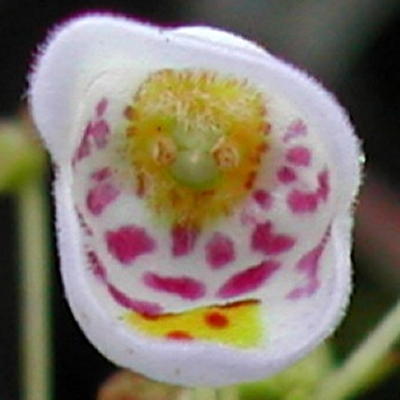| Home |
Strange Wonderful Things Rare and exotic plants |
 |
|---|
Germinating the seeds
If you have germinated seeds of Begonias before (not terrarium Begonias) you may use the same technique that worked for you, since the germination requirements are similar.
Getting started -- Use about 6 to 10 small pots that are 2-4 inches (5-10 cm) tall. The pots should have drainage holes.
The soil should be well-draining and high in organic matter. A typical soil mix for germinating them is 3 parts sterilized potting soil to 2 parts perlite or coarse sand. An alternate mix is equal parts of coir fiber and perlite, with some slow-release fertilizer mixed in. Fill each container with the soil mix and water it until it is evenly moist, but not soggy.
The seeds are very tiny, so work in a well-lit area. Sprinkle several seeds evenly across the surface of each pot. To make it easier to pick up the seeds, breathe on your finger tip to slightly moisten it, then dab a few seeds with it. After sprinkling them on the surface, drip a few drops of water over them, to spread the seeds down into the cracks of soil, which will keep them moist, but still give them light. Do not bury the seeds with soil.
Until the seeds sprout, ensure that the soil surface never dries out. I recommend enclosing the pots in a plastic container or bag to maintain moisture. Leave it open a crack to let some fresh air in. Each day, drip a few drops of water on the surface to keep it moist.
The seeds germinate well between 65-74 degrees F (18-23°C). Avoid letting them get above 77°F (25°C). I recommend placing a minimum/maximum thermometer near the pots.
The seeds need light to germinate, so place the containers in a bright spot out of direct sun. A fluorescent bulb kept 5 inches (12 cm) above them provides the right amount of light.
The seeds should start sprouting in 2 to 4 weeks, but may take longer at cooler temperatures. Keep giving them bright, indirect light after they sprout.
Watering -- Once the seedlings are a month old, you may stop keeping the soil surface moist at all times. Aim to keep the rest of the soil evenly moist (but not soggy).
When the seedlings are a month old, you may carefully pull them and transplant them, however i recommend simply cutting off any slower ones, and leaving 1 strong seedlings in each pot.
Lighting -- Jovellana likes filtered sun or bright shade + morning sun. Protect it from strong afternoon sun.
Fertilizing -- This species likes fertile soil. Feed about every 2 months with a slow-release (pelleted or organic) fertilizer. If your potting soil contains nutrients (check the package) your seedlings shouldn't need feeding the first 3 weeks.
It's normal for an older leaf to occasionally turn yellow and drop, but if it seems excessive, the plant may need more nitrogen fertilizer. The soil could also be too dry down in the root zone.
Transplanting -- When the seedlings are about 3 months old, repot to a larger container, about 1 quart (1 liter) in size. For the first week after repotting, give shade, and no fertilizer.
Climate -- The Teacup Flower comes from cool areas of central Chile, where the weather is spring-like all year. The ideal temperature seems to be between 40 and 80 degrees F (4-27°C). I don't know if it will thrive in areas that are consistently above 85° (29°C), especially if nights are warm. It can probably survive a few degrees of frost if given overhead protection, although i recommend protecting it from all frost.
Over about 40-50% humidity is recommended. Indoors, if the humidity drops too low in winter, consider using an ultrasonic humidifier, which you can get at thrift shops and home improvement stores.
If you have any questions, please email me.
Enjoy your plants!
- Jeff
Strange Wonderful Things
| Home |
Strange Wonderful Things Rare and exotic plants |
|
|---|---|---|
| Entire site Copyright 2003-2025 by Strange Wonderful Things, except as noted | ||

